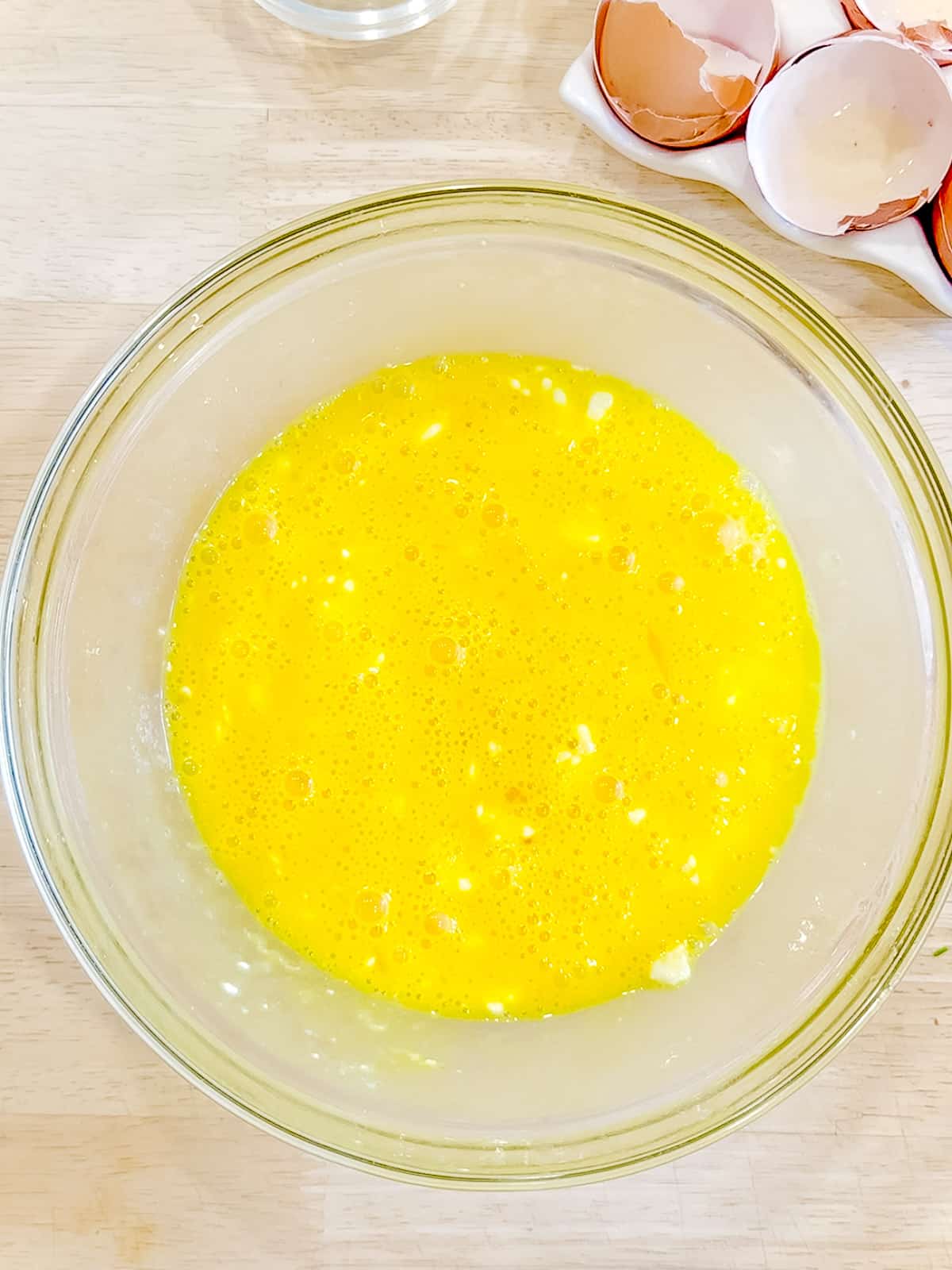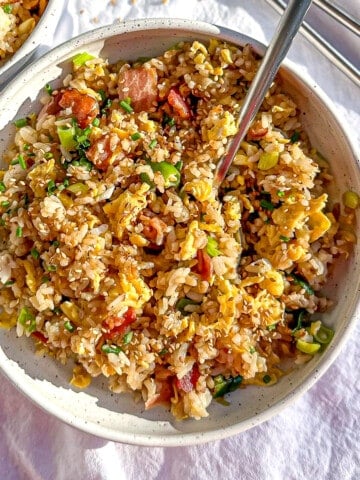Four ingredients and ten minutes to the creamiest, softest scrambled eggs. These Creamy Ricotta Scrambled Eggs are custardy and light as a cloud and they are sure to be your new favorite way to eat eggs!

Save This Recipe! 💌
Making Ricotta Scrambled Eggs is so much easier than you can imagine. The key is to not rush things. I like to cook my scrambled eggs low and slow, something I learned from watching Wolfgang Puck cook eggs years ago. Whether it takes 2 minutes or 5 minutes to make scrambled eggs is such a small difference in time, but makes a world of difference in the results.
Heat, time, and technique determine what kind of eggs you'll be serving. Cooking quickly at high heat will result in American-style scrambled eggs, with big, solid curds. We will be using a more French-style technique, cooking gently over lower heat, yielding soft and creamy scrambled eggs. Adding ricotta cheese, both when whisking your eggs and when cooking them, will give you the creamiest scrambled eggs ever.
Jump to:
Ingredients
When a dish has so few ingredients, there's nowhere to hide. Using the best ingredients you can afford and treating them with respect will give you the best results.

- Ricotta - For the creamiest, custardy eggs, use whole milk ricotta. If possible, make your own ricotta! It only takes about 30 minutes and the flavor and texture difference is amazing! If you don't have ricotta, you can substitute with cream cheese like in my soft scrambled eggs recipe, you can make creamy mascarpone eggs, or add cottage cheese for high-protein scrambled eggs.
- Eggs - Since breakfast is usually the only meal I get to share with my husband, I try to use the best eggs I can. I splurge a bit here and use only organic pasture raised eggs, but you should use the best eggs that you can afford.
- Butter - I use unsalted butter, but other than that, I'm not too fussy about what butter I use. If I'm making puff pastry I might splurge on a good European or New Zealand butter, but not here.
- Salt - I use kosher salt. If you are using common table salt, like Morton's, use half the amount of salt called for in the recipe. (see more about salt in the note below)
See recipe card below for quantities.
Variations
They're your eggs. Have them your way! Here are a few suggestions:
- Green eggs and ham - Fold in pesto and a little bit of prosciutto.
- Everything bagel - Replace the ricotta with cream cheese and fold in some smoked salmon at the end. Sprinkle with everything seasoning.
- Omelette - You can skip whisking ricotta into your eggs, and just fold it in and roll up your eggs, for a more traditional omelette vibe.
Better with bacon: Take your eggs to the next level by crumbling up some Baked Crispy Prosciutto and sprinkling it all over the top. so good! (okay, technically it's Italian ham, but it eats like bacon and I love it like bacon 🥰)
Equipment
Other than your ingredients and your technique, the most important element to good eggs is to use the right pan. There are resources that will tell you why using a cast iron or a stainless steel pan is superior, but for consistent success, and eggs that don't stick, what you really need is a good large nonstick pan.
Not as much of a workhorse as cast iron, and not as durable as stainless steel, a good nonstick pan is an essential in my kitchen for things like eggs, fish, and pancakes. Because all nonstick wears and scratches eventually (the recommendation is to replace yours every 3 to 5 years), don't spend a fortune. My Tramontina nonstick pan is less than $35 and has never let me down.
Don't feel like scrambling? Try my Easy Hard Boiled Eggs! My recipe has 2 different ways to cook your eggs and tips for easy peeling too! Check it out!
Expert tip
All of my recipe cards have an option that allows you to adjust the recipe amounts in half or to double them. If cooking fewer eggs, or more eggs, you will need to adjust pan size accordingly, and note that cooking time can vary.
If cooking a half batch, or three eggs, I would recommend using a smaller non-stick pan, as using too large of a pan would expose too much of the eggs to the heat at one time, increasing the chances your eggs will be overcooked.
If doubling the recipe, I would recommend using a larger nonstick pan, or cooking two separate batches, as the cooking time would be overly extended, possibly resulting in unevenly cooked eggs.
Short Recipe Video
Instructions
Mixing your eggs
If possible, leave your eggs and your ricotta on the counter to come to room temperature for about 30 minutes. Your eggs will cook more evenly and the ricotta will better blend into the eggs and melt while cooking.

1. Crack your eggs into a large bowl.

2. Add half of your ricotta to the eggs.

3. Use a whisk to vigorously mix the ricotta into your eggs.

4. Your eggs are well mixed when there are no more streaks of yolks or whites visible and the ricotta is mostly combined.

5. If you want your eggs even more mixed and your eggs to have a fluffier texture, you can use an immersion blender to fully combine the eggs and ricotta.

6. When using an immersion blender your eggs will lighten in color and there will be very little visible ricotta, if any.
Cooking your eggs
Before starting to cook, make sure you have your plates out and ready to receive their portion of eggs. Leaving your eggs in the pan will cause them to overcook. Your eggs will continue to cook from the residual heat, so remove them from the heat when they still glisten with moisture.

1. Heat a nonstick pan to medium heat and add butter to melt. Just before cooking, add a pinch of salt to your eggs and whisk them.

2. Pour the eggs into the skillet and immediately reduce your heat to medium-low.

3. Allow the eggs to set for about 15 seconds and then run a spatula across the surface of the pan, scraping the cooked eggs off to the side and allowing uncooked egg to take their place against the surface of the pan.

4. Scrape your spatula along the bottom and sides of the pan to continue to form curds and to prevent any part of the eggs from drying out. If at any time the eggs seem to be cooking too quickly, continue stirring while removing the pan from the heat for about 30 seconds.

5. Continue cooking the eggs until they are about 90% done and they are still glistening with moisture. Take your pan off the heat and dollop the remaining ricotta on top of the mostly cooked eggs.

6. Fold the eggs over the ricotta. Transfer directly to serving plates. Garnish with fresh herbs and cracked black pepper, if desired.

Looking for the best side dish? My Diner style Crispy Home Fries are the perfect thing to make any morning!
Serving Suggestion

Sunday Brunch is a great time to catch up with family and friends over great food. Bring home the dream of an Italian Inspired Brunch, including this recipe!
Recipe FAQ's
I always like to use eggs that have been taken out of the fridge at least 30 minutes before cooking. If you don't have that time, submerge your uncracked eggs in a bowl of warm water for 5 to 10 minutes to take the chill off of them.
There are a lot of opinions on this. There are some who say that salting before cooking can lead to tough, watery eggs, but honestly I haven't noticed the difference. I add a pinch of salt immediately before starting cooking and salt my serving to taste at the table.
Absolutely. The usual formula for adding dairy to eggs is 1 tablespoon milk or cream for every two eggs. The fat in the dairy will coat the egg proteins, making them softer and creamier.

Storage and Reheating
Storage
I rarely make enough scrambled eggs to have leftovers, but if you do, store leftover eggs in an airtight container in the refrigerator for up to 4 days.
Reheating
It's difficult to reheat leftover eggs without overcooking them. That's just a fact. They are never going to be the same creamy ricotta scrambled eggs you started with, but here are a couple ways I've had success in reheating eggs, and a couple ways I would probably skip.
- Water bath - The best way to gently reheat your ricotta scrambled eggs is a bit of a hassle, but has the best result. Heat a pot of water until almost boiling and remove from heat. Place your eggs in a vacuum seal bag or freezer zip top bag, removing all excess air, and place in the water until the eggs are hot, about 10 to 15 minutes.
- Oven - If you have a larger quantity of eggs to reheat, say you made a double batch, place them in a buttered dish, cover them with a lid, or aluminum foil and place in a 300°F oven for 15 minutes, or until hot.
- Microwave - If you just want hot eggs and don't care if they're a bit overdone, just zap them in the microwave for about 30 to 45 seconds.
- Stovetop - No. Just make new eggs. Love yourself.
I guess all this is to say, just make as many eggs as can be eaten in one sitting. Reheating can either be a hassle or a disaster. You'll be happier making them fresh!

Did you try this recipe?
Please consider leaving a comment with a ⭐️ rating below and tell me all about it! It helps me to continue to improve my content and lets others know what you think!
I appreciate it so much!
-Cynthia
📖 Recipe

Creamy Ricotta Scrambled Eggs
Ingredients
- 6 large eggs
- ½ cup ricotta cheese whole milk preferred
- 2 tablespoons unsalted butter
- ⅛ teaspoon kosher salt
- Chopped chives optional garnish plus other herbs as desired
Instructions
- Crack your eggs into a large bowl and add half of the ricotta. Use a large whisk to vigorously mix the ricotta into your eggs.
- If you want your eggs even more mixed and your eggs to be even fluffier, you can use an immersion blender to fully combine the eggs and ricotta.
- Heat a nonstick pan to medium heat and add butter to melt. Just before cooking, add a pinch of salt to your eggs and whisk them.
- Pour the eggs into the skillet and immediately reduce your heat to medium-low. Allow to set for about 15 seconds and then run a spatula across the surface of the pan, scraping the cooking eggs off to the side and allowing uncooked egg to take their place against the pan.
- Scrape your spatula along the bottom and sides of the pan to continue to form curds and to prevent any part of the eggs from drying out. Continue cooking the eggs until they are about 90% done and they are still glistening with moisture.
- Take your pan off the heat and dollop the remaining ricotta on top of the mostly cooked eggs.
- Fold the eggs over the ricotta and stir in. Transfer directly to serving plates. Garnish with fresh herbs and cracked black pepper, if desired.










Erin says
I always do WAY too much to eggs (add a bunch of veg and cheese, always douse it in Sriracha or salsa, etc.). I'd seen a tip about ricotta and really wanted to try it, so I made it AS IS. Absolutely fantastic. So fluffy and light. Just butter, salt and airiness. Yummy!!
Shem Ishler says
So delicious!